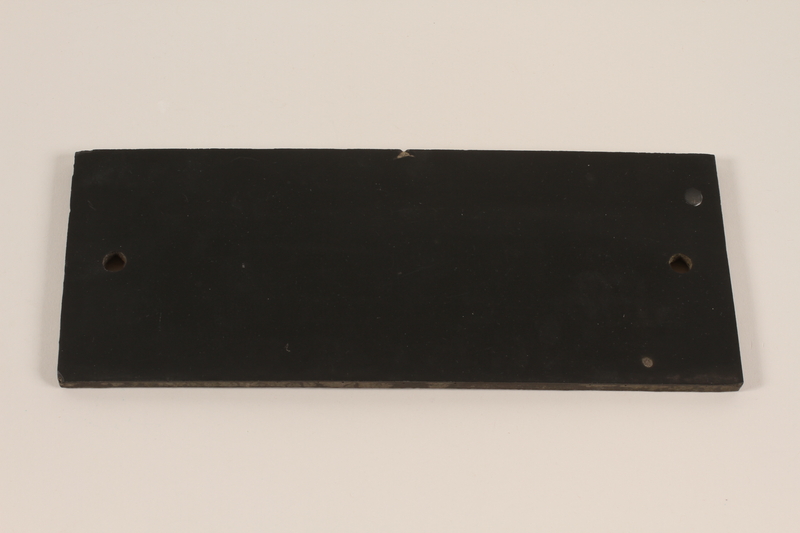Chaim Kozienicki was born June 16, 1928 in Łódź, Poland, to Chaja Sura, born in 1900, and Szulem, born 1889. He had one brother, Ezra Zeli, born August 24, 1925. When the Germans occupied Łódź in 1939, Jewish men were especially subject to persecution and capture for forced labor, so Chaim’s father fled to Brzeziny and Warsaw. When he returned after a short time, Chaim was given the task of being on the lookout to see when it was safe for his father to go out of their apartment.
In March 1940, Chaim’s family was moved by the Germans to the Łódź ghetto. Chaim was eleven years old. At first, he felt a sense of adventure, and relief at being separated from the Germans and the threat of random abductions. He and his family lived with relatives, then moved to a wooden hut where they had a small plot where they could grow vegetables. The hut was near the barbed wire fence that bordered the ghetto. German soldiers took random shots at Jews along the fence, so Chaim’s family was especially at risk. At night, they were not able to go out of the hut to the outhouse because of the danger.
Chaim joined the Hanoar Hatzioni Zionist youth group. His brother joined a Communist group and objected to Chaim’s involvement with the Zionist group. Chaim also attended school in the ghetto. His maternal grandfather started Chaim’s training to become Bar Mitzvah. In the fall of 1941, the school closed. Chaim’s grandfather died of hunger.
The winter of 1941-1942 was very harsh, though Chaim’s involvement with the Zionist youth group helped keep his spirits up. He worked in the leather factory. In June 1942, he became Bar Mitzvah in a simple ceremony at home of putting on tefillin for the first time. His family gave him half a loaf of bread as a present. When he thought of the sacrifices his family had made to be able to give him the bread, he had difficulty eating it.
In September 1942, the “Gehsperre” Aktion occurred. All children, the elderly, and the sick were to be rounded up. Chaim’s family was at risk of being taken because his brother and his parents were sick and showed signs of starvation. The family waited in their hut and had a last meal of vegetable soup using produce from their garden plot. As they ate, they heard crying and shouting outside. Chaim wore his mother’s shoes with higher heels to try to look older. By luck, a German soldier looked in the small window but missed seeing the family inside, so they were not taken during the Aktion.
Chaim continued to work in the leather factory, then in the tapestry factory, then in a tailor factory in the hospital building on Lagiewnicka 36. He continued his Zionist activities, switching to the Betar movement. In August 1944, the final liquidation of the Łódź ghetto by the Germans was underway. Chaim became ill and was hospitalized. His mother visited him each night, but one night she did not show up. She and Chaim’s father had been deported that day.
Chaim was deported soon after. He arrived at the Auschwitz-Birkenau concentration camp (Auschwitz II) on September 1, 1944. He saw his father briefly and learned that his mother had been selected for death upon arrival at the camp. Chaim never saw his father again.
On his first day at Auschwitz-Birkenau, Chaim was transported by freight train to Stutthof concentration camp, where he was put to work in a concrete plant. A few weeks later, he was moved to Stolp concentration camp, where there were workshops for repairing railroad cars. In February 1945, as the Soviet army approached, the inmates were taken to Burggraben, a sub-camp of Stutthof. Chaim was then taken on a death march, and finally on a barge on the Baltic Sea to Neustadt, Germany. Chaim was liberated there by the American Army in May 1945. He was hospitalized and found to have tuberculosis. The Red Cross transferred him to Sweden, where he convalesced for nine months.
His brother Ezra found him through a Red Cross list. Chaim also made contact with relatives in Palestine: his paternal grandfather, his father’s brother, Raphael, and his father’s sister, Rivka. In January 1947, Chaim boarded an illegal immigration ship to Palestine. The ship arrived February 22, 1947. The British arrested the passengers and sent them to the Atlit internment camp. Chaim escaped from the camp and lived on kibbutz Ramat Hasharon. In 1948, he joined the new nation of Israel’s defense forces and fought in the War of Independence. In 1950, he married Esther Zalcberg, a survivor from Bedzin, Poland. They were married for 52 years, until Esther passed away in 2003. They have two children.
Gitla Herszkowicz (Hebrew name Gitla bat Shmuel) was a Jewish resident of Łódź, Poland, when the Germans occupied the city in 1939. At the time of the occupation, she was married and had children and grandchildren who also lived in Łódź. In March 1940, the Germans forced Gitla and her family to move into the ghetto. Gitla and her husband lived in a wooden hut with her daughter and her family, Chaja and Szulem Kozienicki and their 2 sons, Chaim and Ezra. Gitla died on August 4, 1940. Her husband died of starvation near the end of 1941. Her daughter and son-in-law were deported and killed in Auschwitz death camp in 1943. Chaim and his brother were also deported to Auschwitz, but they both survived, though most of their other relatives perished during the Holocaust.




